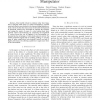Free Online Productivity Tools
i2Speak
i2Symbol
i2OCR
iTex2Img
iWeb2Print
iWeb2Shot
i2Type
iPdf2Split
iPdf2Merge
i2Bopomofo
i2Arabic
i2Style
i2Image
i2PDF
iLatex2Rtf
Sci2ools
101
click to vote
ICRA
2006
IEEE
2006
IEEE
Static Analysis of Contact Forces with a Mobile Manipulator
— Most mobile robots in existence today have large, heavy, statically stable bases. To enable manipulation, actuated arms and effectors are attached to the base providing limited postural control. On the other hand, some of the latest developments in humanoid robotics have succeeded in reducing the footprint and raising the center of mass of a robot using whole body postural control and balancing. By comparing the magnitude of various forces that can be applied to the environment, we demonstrate the advantages of whole body postural control. The results presented suggest that for pushing, pulling, or carrying types of tasks, using whole body postural control can lead to higher performance by allowing a platform to apply more force to the environment.
Related Content
| Added | 11 Jun 2010 |
| Updated | 11 Jun 2010 |
| Type | Conference |
| Year | 2006 |
| Where | ICRA |
| Authors | Bryan J. Thibodeau, Patrick Deegan, Roderic A. Grupen |
Comments (0)

